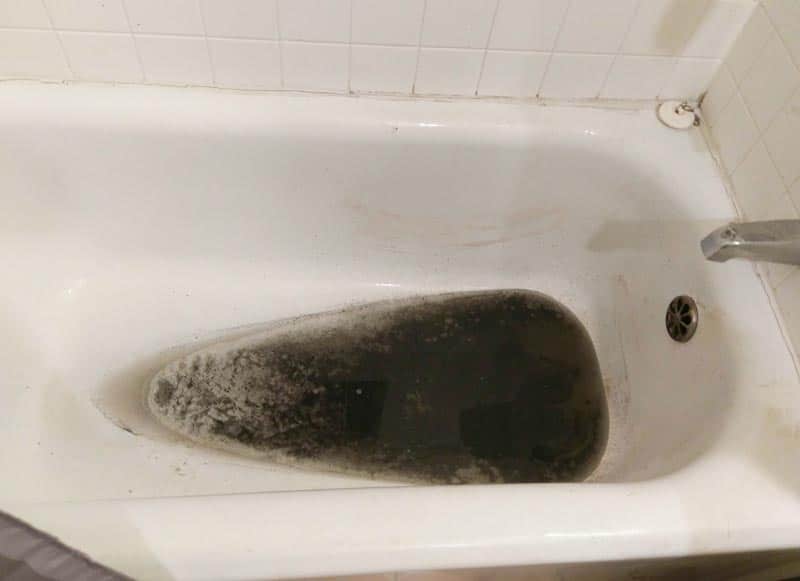Our Definitive Explanation: Sewage Coming Up Through the Bathtub
Our Definitive Explanation: Sewage Coming Up Through the Bathtub
Blog Article
Are you in search of critical information involving What to Do if Sewage Starts Coming Up Through Your Bathtub?

Sewer backup in the bath tub can be a traumatic and unhygienic trouble for any home owner. Not just is it troublesome, yet it also postures significant wellness threats and shows underlying issues with the plumbing system. Understanding why sewer is coming up via the tub is crucial for taking ideal action to attend to the issue efficiently.
Intro to the Issue
Recognizing the Problem
When sewer draws back up into the bathtub, it's a clear sign of a trouble with the drain system. The wastewater that should be flowing away from your home is instead finding its back right into your home, which can lead to considerable damages and health hazards.
Prospective Causes
Several factors can contribute to sewer backup in the tub. From clogs in the sewer line to problems with the plumbing facilities, recognizing the source is vital for locating a remedy.
Typical Reasons for Sewage Backup
Obstructions in the Sewer Line
Among the most common sources of sewer back-up is a clog in the sewer line. This can occur due to the accumulation of debris, grease, or foreign things in the pipelines, protecting against proper flow and causing sewer to back up right into your bathtub.
Tree Origin Invasion
Tree origins seeking dampness and nutrients can penetrate drain lines via tiny cracks or joints. Over time, these roots can expand and increase, triggering considerable damages to the pipelines and resulting in sewage backup issues.
Aging Framework
Older homes might have outdated plumbing systems that are extra vulnerable to rust, splits, and deterioration. As pipes age, they become much more prone to leaks and clogs, increasing the likelihood of sewer back-up incidents.
Heavy Rainfall or Flooding
Throughout periods of heavy rainfall or flooding, the drain system may become overwhelmed with excess water, causing backups and overflows. This can result in sewage supporting right into tubs and various other fixtures inside the home.
Health Risks Connected With Sewer Back-up
Contamination of Supply Of Water
Sewage backup can infect the supply of water in your home, posturing a serious health and wellness risk to you and your family members. Exposure to polluted water can cause intestinal concerns, skin infections, and other ailments.
Spread of Disease
Sewage contains dangerous germs, infections, and bloodsuckers that can create a range of illness, consisting of liver disease, cholera, and gastroenteritis. Entering into contact with sewer or infected surface areas puts you in danger of infection.
Mold Growth
Moisture from sewer backup can develop optimal conditions for mold development in your house. Mold and mildew spores can intensify respiratory system troubles and trigger allergic reactions in delicate individuals, making prompt cleanup necessary.
Indicators of Sewer Back-up
Foul Odors
Undesirable odors emanating from drains or components, specifically in the restroom, might indicate sewage backup issues. These odors are usually solid and consistent, signifying an issue that calls for instant attention.
Slow Draining Fixtures
Tubs, sinks, and commodes that drain slowly or not in all could be experiencing sewer back-up. If numerous components are affected all at once, it's most likely that the issue originates from an usual factor, such as the primary drain line.
Gurgling Noises
Strange gurgling or bubbling sounds originating from drains when water is running elsewhere in the house are indicative of air trapped in the plumbing system. This air buildup can result from sewer back-up and must be examined quickly.
Immediate Actions to Take
Turning Off Water Supply
In the event of sewer backup, it's essential to switch off the water system to avoid additional contamination and damages. Situate the major water shutoff valve in your house and closed it off till the concern can be resolved.
Speaking To a Professional Plumber
Handling sewer back-up is not a DIY work. Get in touch with a qualified plumber with experience in taking care of sewage-related problems to assess the circumstance and do required repairs or clean-ups.
Staying Clear Of Contact with Contaminated Water
Up until the sewer back-up is solved, stay clear of contact with polluted water to avoid the spread of bacteria and virus. Wear safety gear if you must remain in the damaged location and wash your hands completely afterward.
Preventive Measures
Routine Maintenance of Sewer Lines
Schedule normal assessments and upkeep of your sewer lines to determine and deal with prospective problems before they rise right into major troubles. This can consist of cleaning out debris, examining for tree root intrusion, and fixing any type of damaged pipelines.
Installing Backwater Valves
Think about mounting backwater valves in your plumbing system to prevent sewer from receding right into your home throughout periods of heavy rainfall or flooding. These valves instantly close when water starts backing up, shielding your property from contamination.
Correct Disposal of House Waste
Prevent purging anything aside from toilet tissue and human waste down the commode to stop clogs and obstructions in the drain line. Dispose of grease, oil, and various other family chemicals properly to reduce the danger of plumbing troubles.
Cleaning Up After Sewage Back-up
Sanitation Procedures
Completely decontaminate and sterilize affected areas after sewage back-up to get rid of dangerous germs and stop mold and mildew development. Use suitable cleansing products and safety gear to make certain secure and efficient clean-up.
Remediation of Influenced Locations
Fix any type of damage to flooring, walls, or fixtures triggered by sewer back-up. Depending on the level of the damages, you may need to replace carpets, drywall, or other materials to recover your home to its pre-loss condition.
Why Is Water Backing Up in My Bathtub When I Flush My Toilet?
What to do about a sewer line clog
First, don’t bother with plunging. No amount of plunging will dislodge the clog in a sewer line. The clog is too far away. Plungers are for clogs in the toilet itself, not the sewer line. Plus, the most likely causes of a sewer clog are:
Tree roots Flushed toys or feminine products Grease buildup Those items don’t move easily. And in the case of tree roots, the roots need to be cut out of the pipe and the pipe will need to be repaired.
You’ll need a closet auger. A closet auger is a type of plumber’s snake with a protective cover to keep from scratching the delicate porcelain toilet. If the clog is further down, you may need to remove the toilet or use one of your cleanouts to get to the clog.
We also recommend doing a video inspection of the drain to ensure that the cause of the clog has been completely removed. Otherwise, you could have the same problem again in a few days or weeks.
https://mspplumbingheatingair.com/blog/why-is-water-backing-up-in-my-bathtub-when-i-flush-my-toilet

We are very fascinated by Why is Sewage Backing Up Into My Bathtub? and I hope you enjoyed reading the new blog entry. Loved our entry? Please quickly share it. Let others locate it. We recognize the value of reading our article about Why is Sewage Backing Up Into My Bathtub?.
Call Today
Report this page